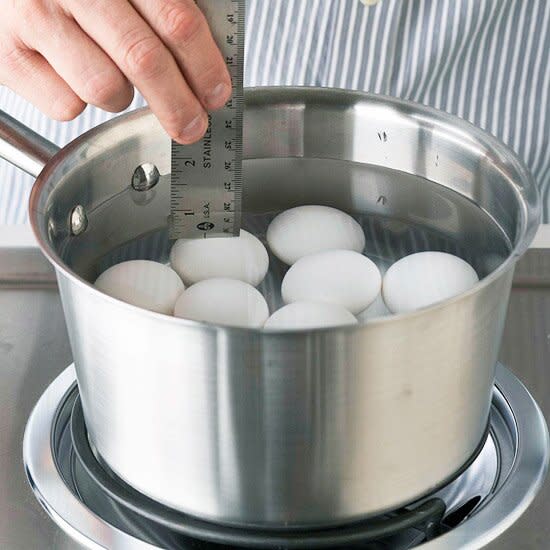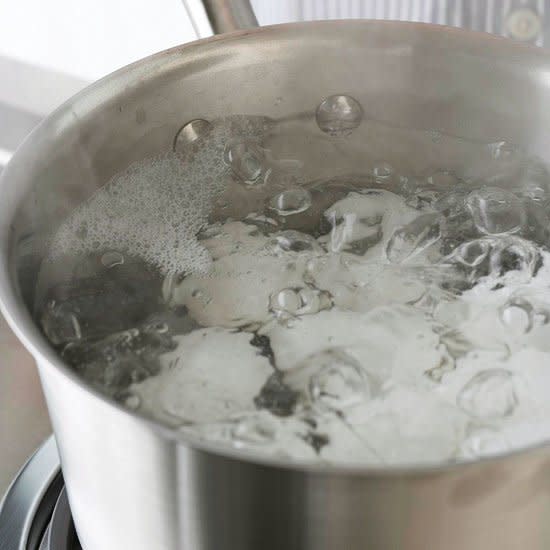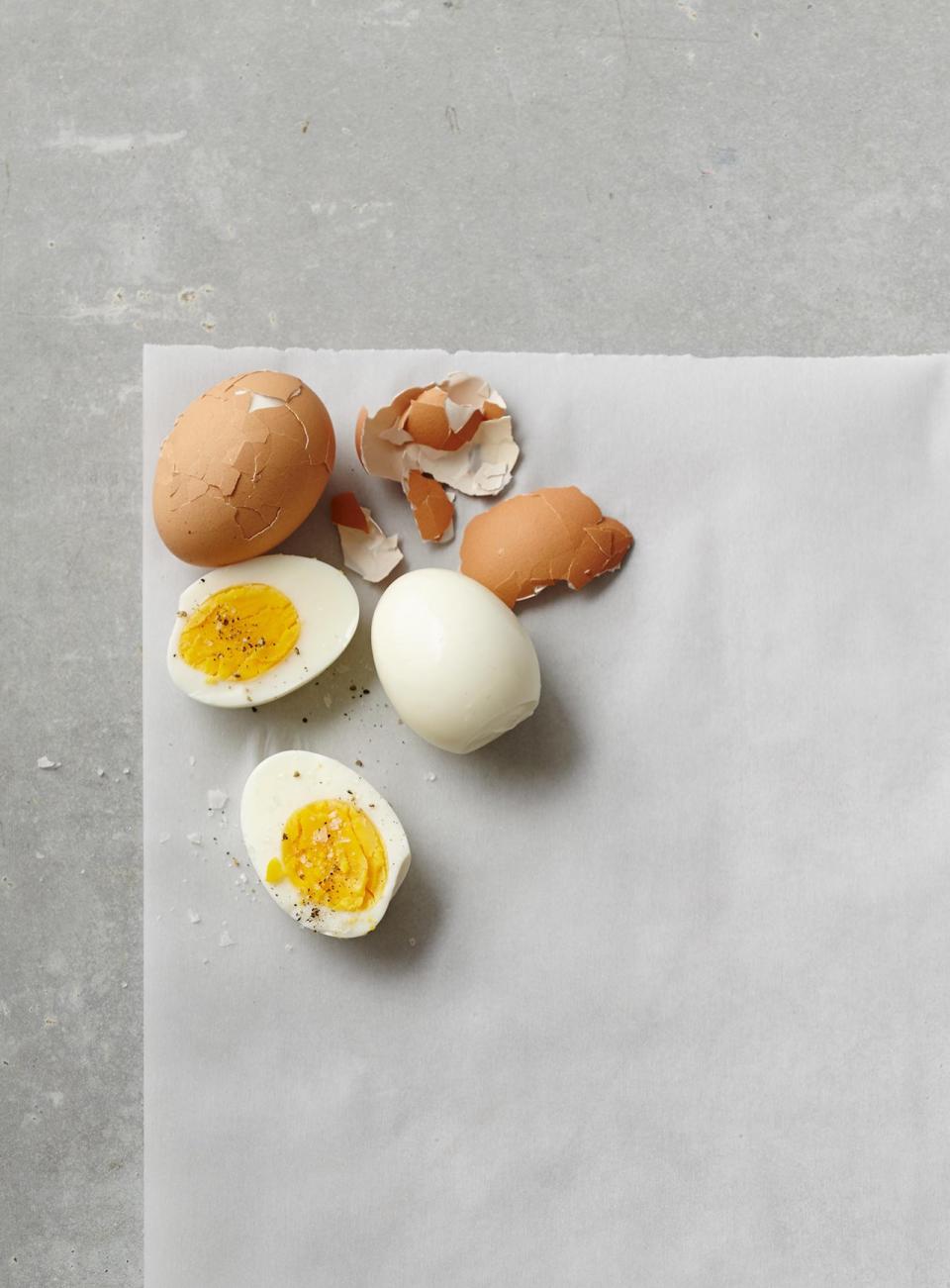How to Boil an Egg 3 Different Ways
The method for making perfect hard-boiled eggs is highly debated. Some swear by steaming, others use the classic technique of boiling water on the stove, recently people are turning to their Instant Pots and pressure cookers to make them. We'll teach you how to make boiled eggs each way, including soft-boiled eggs for those of you who love a runny yolk.

1. How to Hard-Cook Eggs (aka How to Hard-Boil Eggs) on the Stove
You're not technically boiling the eggs so hard-cooked eggs is the more accurate term, but you are bringing water to a boil. Whatever you call it, here's how to do it:
Place eggs and water in a saucepan
Arrange the eggs in a single layer in a large saucepan so they cook evenly.
Test Kitchen Tip: Do not stack eggs, this will alter the cooking time and could result in eggs being cooked to different levels of doneness.
Add enough cold water to cover the eggs by 1 inch.

Bring water to a boil
Heat saucepan over medium-high heat until the water comes to a rapid boil (water will have large, rapidly breaking bubbles).
Immediately remove pan from heat.
Cover and let stand
After removing from heat, cover the saucepan and allow it to stand for 15 minutes. See the section toward the bottom to learn how long to cook soft-boiled eggs using this technique.
Drain the eggs, place them in ice water until cool enough to handle; drain again.
2. How to Make Steamed Hard-Boiled Eggs
This is the technique getting all the praise as it seems to result in easier to peel eggs after cooking. It's similar to the classic method of cooking in water, just with the addition of a steamer basket so the eggs never actually touch the water. Here's how to steam eggs:
Place 1 inch of water in a 4-quart Dutch oven or deep skillet. Add a steamer basket. Bring water to boiling over high heat.
Carefully add eggs using a slotted spoon. Cover; do not reduce heat. Steam for 17 minutes.
Test Kitchen Tip: Don't let your pan boil dry while the eggs are steaming. If you run out of water, add more boiling water to the pan.
Remove with a slotted spoon to a bowl of ice water to cool.
Related: Get our Steamed Eggs recipe
3. How to Make Instant Pot Hard-Boiled Eggs
Yes, you can make hard-boiled eggs in your pressure cooker. Get our step-by-step directions for Instant Pot eggs here so you can cook for the correct amount of time for your desired doneness. But here's the gist:
Add the steamer rack to your pressure cooker.
Add 1 cup of water and up to 10 eggs (in a single layer) on the rack.
Lock the lid and cook on high pressure to your desired doneness.
Get the recipe: Pressure Cooker Hard-Boiled Eggs

How to Peel Hard-Boiled Eggs
To peel an egg, gently tap it on the counter to crack the shell. Roll the egg on the countertop under the palm of your hand. Use your fingers to peel off the shell starting at the large end.
Rinse the peeled egg under cold water to remove any remaining bits of shell.
Related: Top tips for making peeling eggs a cinch!
Test Kitchen Tip: For easier to peel eggs, start by cooking eggs that are 7 to 10 days old. As eggs age, the air pocket in the shell grows, making it easier to dislodge the shell after boiling.
How to Soft-Boil an Egg
The method for how to soft-boil an egg is very similar to hard-boiling—the main difference is time. Follow this easy method for quick soft-boiled eggs:
Bring water to a boil.
Using a slotted spoon, lower eggs into the water.
Reduce heat to maintain a gentle boil.
Cover and cook 6 minutes for soft-boiled eggs.
Test Kitchen Tip: If you like your yolk more "jammy" like an hybrid of hard and soft yolk, cook using the gentle boil for 8 minutes.
Poaching Eggs
If you're wondering about how to poach eggs, which also requires boiling water, get our directions on how to poach eggs.
How to Use Boiled Eggs
Boiled eggs can be delicious all on their own, but they're also a great way to give salads like our New Potato, Avocado, and Egg Salad recipe and other recipes an extra boost of protein. Here are a few different ideas for adding both poached and hard-cooked eggs to your plate:
Make deviled eggs! You can stick to the classic version for holidays and party appetizers, or you can try one of our dressed-up versions. Try our whole collection of deviled egg recipes.
Top off a hearty breakfast bowl! Thanks to the runny yolk inside, poached eggs are ideal for topping off a bowl full of breakfast goodies like mushrooms, tomatoes, and kale. It can also be a sneaky way to enjoy all your favorite omelet fixings without the extra wait time. Try it out with our Poached Egg Breakfast Bowls.
Add them to a sandwich! Hard-cooked or poached, you can improve any plain sandwich by putting an egg on it. Up your lunchtime game with our Ham and Egg Sandwiches recipe.
Choosing and Storing Eggs
Select clean, fresh eggs from refrigerated display cases. Avoid dirty or cracked eggs, which may be contaminated with harmful bacteria.
Refrigerate eggs in their cartons so they don't absorb refrigerator odors. Be sure to store eggs with the pointed ends down, which maintains freshness by keeping the yolks centered and the air cells stable.
Fresh eggs can be refrigerated for up to 5 weeks after the packing date (a number stamped on the carton from one to 365, with one representing January 1 and 365 representing December 31).

